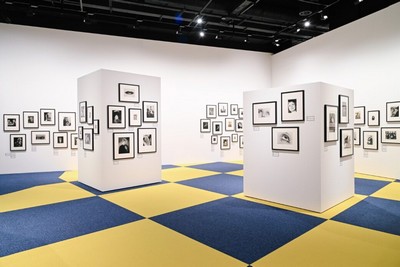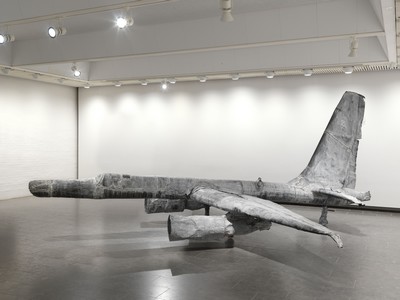The Anxious Eye:
German Expressionism and Its Legacy
National Gallery of Art, Washington
February 11 - May 27, 2024
Nude, 1909
Watercolor on brown paper
overall: 33.8 x 43.9 cm (13 5/16 x 17 5/16 in.)
National Gallery of Art, Washington, Rosenwald Collection
Two Bathers, c. 1920
Color crayons and watercolor
overall: 68.7 x 52.8 cm (27 1/16 x 20 13/16 in.)
National Gallery of Art, Washington, Rosenwald Collection
The Fall of Man (Der südenfall), 1919
Color woodcut monotype
sheet: 30.5 x 23.5 cm (12 x 9 1/4 in.)
National Gallery of Art, Washington, Ailsa Mellon Bruce Fund
Couple in the Woods (Menschen Im Wald), 1918
Color woodcut on wove paper
block: 25.1 x 30.2 cm (9 7/8 x 11 7/8 in.)
sheet: 35.2 x 42.4 cm (13 7/8 x 16 11/16 in.)
National Gallery of Art, Washington, Gift of Ruth Cole Kainen
Group Portrait, Eden Bar (Gruppenbildnis Edenbar), 1923
Woodcut on heavy Japan paper
National Gallery of Art, Washington, Rosenwald Collection
Through their bold distortions, angular, simplified forms, and use of non-naturalistic colors, the German expressionists sought to convey complex emotional and psychological responses to their changing world during the social, cultural, and political upheavals of the early 20th century. Dissatisfied with conventional social norms, the German expressionists rejected academic conceptions of idealized, timeless beauty and instead pursued daring artistic strategies that would both reflect and contribute to revolutionary change. The Anxious Eye: German Expressionism and Its Legacy presents insights into the work of these inventive artists and their continuing impact in the 21st century. Many of these artists were drawn to the expressive possibilities of printmaking. They achieved a range of textures and tonalities in their prints, from the fine, velvety lines of drypoint to the alternating crisply splintered or gesturally gouged marks of woodcut, and from the granular crayon and wash-like drawing effects of lithography to the subtle shifts in continuous tone that are possible in aquatint. Additionally, the various approaches to applying ink and use of different color inks in their prints were well suited to the artists’ desire to experiment with materials.
The exhibition is on view in the West Building of the National Gallery of Art. It features more than 100 prints, drawings, illustrated books, portfolios, and two sculptures. The works range in date from 1908 to 2021. All of the works, including recent acquisitions and works that have rarely been on view, are drawn from the National Gallery’s permanent collection. Works by such well-known artists as Erich Heckel, Ernst Ludwig Kirchner, Käthe Kollwitz, Emil Nolde, and Egon Schiele will be seen alongside prints by lesser-known artists, including Paul Gangolf, Walter Gramatté, and Otto Mueller.
“This exhibition invites visitors to consider the striking parallels between the intensity of human emotion and experience conveyed in the work of the German expressionists during a transformational historic period in the early 20th century and current responses to the cultural and political shifts taking place in our world today,” said Kaywin Feldman, director of the National Gallery of Art.
Divided into four thematic sections, The Anxious Eye: German Expressionism and Its Legacy features works of art that focus on portraits and modern life; nature and spirituality; relationships and body language; and the “legacy” of German expressionism. This exhibition shares insights drawn from the increased understanding we now have of the complexities and impact of World War I, which concluded more than a century ago in 1918. It also introduces new approaches to broadening conventional art historical narratives. Artists working in Germany and Austria in the 1910s and 1920s challenged themselves to create expressive strategies for making art that reflected a heightened understanding and authentic representation of human experience amidst rapid social, cultural, and geopolitical transformations. The final room of the exhibition explores these ideas in the work of later artists whose similar approaches to mark making, materials, and sense of immediacy have been employed to respond to comparable circumstances and concerns—the most strikingly analogous circumstances being those facing contemporary artists working today.
Die grosse Angst (Selbstportrat, Kopf im Halbprofil nach rechts), 1918
Drypoint with extensive additions in watercolor
Sheet: 30 x 23.81 cm (11 13/16 x 9 3/8 in.)
National Gallery of Art, Washington,
Gift of Christopher and Beverly With
in memory of Karl and Gerda With
The first room features penetrating portraits and self-portraits that focus on inner thoughts and emotional states of being rather than realistic accuracy of appearance. These works draw on concepts that were then emerging about personality traits and states of mind as developed by Sigmund Freud and Carl Jung, groundbreaking psychology scholars and philosophers in the early 20th century. The incisive diagonals, quavering lines, and gnarled fingers of the figure in Die Grosse Angst (The Great Anxiety), Walter Gramatté’s 1918 self-portrait, and the close cropping and gouged, carved, and scratched marks that define the facial features in the woodcut portrait Fanny Wocke (1916) by Ernst Ludwig Kirchner demonstrate the ways artists used the characteristics of different media to impart emotional intensity. Prints and illustrated books by Max Beckmann, Lovis Corinth, Otto Dix, Paul Gangolf, and George Grosz convey the emotional and political timbre of the time by showing the dynamics of modern life, increasingly congested cities and the accompanying sense of isolation and anonymity within them, dissatisfaction with the existing social order and bourgeois values, and the horrors of World War I.
The second gallery presents the religious subjects and landscapes that artists pursued in seeking refuge from the complexities and stress of daily life on one hand, while questioning faith and humankind’s destructive impact on the world on the other. Some of the highlights in this section include Lovis Corinth’s and Otto Mueller’s representations of the Old Testament story of Adam and Eve in the garden of Eden, Karl Schmidt-Rotluff’s dazzling pink and green woodcut of rocky mountains, and Emil Nolde’s murky view of the harbor in Hamburg, Germany.
Two Women (Zwei Frauen), 1914
Color lithograph printed in black and orange
image: 42 x 32 cm (16 9/16 x 12 5/8 in.)
sheet: 53.8 x 41.9 cm (21 3/16 x 16 1/2 in.)
National Gallery of Art, Washington, Gift of Ruth Cole Kainen
Dancer (Tänzerin), 1913
5-color lithograph on japan paper
sheet: 60.2 x 77.5 cm (23 11/16 x 30 1/2 in.)
National Gallery of Art, Washington, Ailsa Mellon Bruce Fund
Standing Nude with a Patterned Robe, 1917
gouache and black crayon on buff paper
sheet: 29.3 x 45.9 cm (11 9/16 x 18 1/16 in.)
National Gallery of Art, Washington,
Gift of The Robert and Mary M. Looker Family Collection
The German expressionists were fascinated by the ways gestures and movement could signify love, fear, sorrow, joy, and other aspects of people’s emotional state or personality. The different approaches these artists explored to depict the body, sexuality, and interpersonal relationships are featured in the third gallery. The tensions that can arise between husband and wife are represented by the green band that cuts horizontally across the composition in Walter Gramatté’s The Couple (Self-Portrait with Wife) of 1922. Love and security are felt in Käthe Kollwitz’s bronze relief In God’s Hands (1935/1936), which shows a small child protectively enveloped in the arms of an adult (represented only by a pair of hands). Counter to the traditional academic depictions of idealized nudes, these artists embraced a range of body types and discomforting positions, from the exaggeratedly puckered colorful surface of Egon Schiele’s Standing Nude with Patterned Robe (1917) to the awkwardly posed model kneeling on a rug in Erich Heckel’s Nude (c. 1913). Sources of inspiration include the art of Africa and the South Pacific Islands, which were inaccurately viewed through the bias of colonialism as “primitive” societies untainted by “civilization.” Elongated and exaggerated shapes, and the manner of articulation of certain features, as seen in the front-facing figure in Ernst Ludwig Kirchner’s lithograph Two Women (1914) and his rough-hewn wooden sculpture Head of a Woman (1913), and the dynamic movement in Emil Nolde’s color lithograph Dancer (Tänzerin) (1913) demonstrate the artists’ investigation of what they misinterpreted as “primal” aesthetic sensibilities that express vital forces of human experience.
Untitled Anxious Red, 2021
Screenprint on wove paper
Image and sheet: 57.5 x 77.4 cm (22 5/8 x 30 1/2 in.)
National Gallery of Art, Washington, Ailsa Mellon Bruce Fund
The final room presents the legacy of German expressionism and how artists continue to draw upon its stylistic approaches to convey the heightened emotional and psychological experiences that accompany transformational moments in society. Among the highlights is Leonard Baskin’s The Hydrogen Man (1954), whose one-armed transparent figure, rendered in an intricate network of woodcut lines, warns of the ravages of modern nuclear warfare. Rashid Johnson’s grid of highly abstract boxes of “scribbled” faces fills the composition Untitled Anxious Red (2021), which was created during the COVID pandemic. It captures not only the elevated fear of contracting a deadly disease but also the challenge of negotiating the anxiety of being a Black man in America with tensions heightened by the death of George Floyd and the rise of the Black Lives Matter movement. Among the National Gallery’s recent acquisitions are Nicole Eisenman’s Beer Garden (2012–2017), which combines self-portraiture with various “types” of caricatured figures that recall Max Beckmann’s prints in the first gallery, and Orit Hofshi’s Time… thou ceaseless lackey to eternity (2017), in which the artist, standing in a landscape ravaged by war and climate change, is surrounded by displaced people seeking refuge and a path to a better future.
The Anxious Eye: German Expressionism and Its Legacy is organized by the National Gallery of Art, Washington, which is the only venue, and is curated by Shelley Langdale, curator and head of modern and contemporary prints and drawings, National Gallery of Art.
NATIONAL GALLERY OF ART
Sixth Street and Constitution Avenue NW, Washington, DC

























